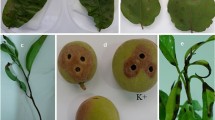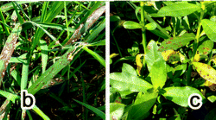Abstract
In the 1980’s the causal agents of bacterial canker of cherry trees in South Africa was reported to be Pseudomonas syringae pv. syringae and Pseudomonas syringae pv. morsprunorum. Subsequently, no further studies were undertaken on the disease or causal agents. The aim of the current study was to conduct field surveys to determine the current situation pertaining to bacterial canker in the major cherry producing areas of South Africa. Following isolations from infected trees, strains were characterized using biochemical as well as multilocus sequence analyses (MLSA). Pathogenicity tests were undertaken with immature cherry fruit as well as three different cherry cultivars. Although symptoms of bacterial canker were present in all areas surveyed, P. syringae isolates were only isolated from three sites in the Western Cape Province. The isolates collected in this study showed a hypersensitive response on tobacco leaves and were pathogenic on immature cherry fruit and cherry trees. The phenotypic tests and MLSA using four genes (cts, gapA, gyrB and rpoD) showed phenotypic and genetic identity with Pseudomonas syringae pv. syringae. Selected strains induced a hypersensitive response on tobacco leaves and were pathogenic on immature cherry fruit and green cherry tree shoots. The current study shows that P. syringae pv. syringae is responsible for bacterial canker in the Western Cape Province, South Africa.






Similar content being viewed by others
References
Abbasi, V., Rahimian, H., & Tajick-Ghanbari, M. A. (2013). Genetic variability of Iranian strains of Pseudomonas syringae pv. syringae causing bacterial canker disease of stone fruits. European Journal of Plant Pathology, 135, 225–235.
Agrios, G. N. (2005). Plant Pathology (5th ed.). Amsterdam: Elsevier Academic Press.
Ait Tayeb, L., Ageron, E., Grimont, F., & Grimont, P. A. (2005). Molecular phylogeny of the genus Pseudomonas based on rpoB sequences and application for the identification of isolates. Research in Microbiology, 156, 763–773.
Almeida, N. F., Yan, S., Cai, R., Clarke, C. R., Morris, C. E., Schaad, N. W., Schuenzel, E. L., Lacy, G. H., Sun, X., Jones, J. B., Castillo, J. A., Bull, C. T., Leman, S., Guttman, D. S., Setubal, J. C., & Vinatzer, B. A. (2010). PAMDB, a multilocus sequence typing and analysis database and website for plant-associated microbes. Phytopathology, 100, 208–215.
Alonso, J. S. (2011). Producción, comercialización, Mercado y oportunidades de la cereza. [Sweet cherry production, marketing, and market opportunities]. VidaRURAL, 23, 46–50.
Annesi, T., Motta, E., & Forti, E. (1997). First report of Blumeriella jaapii teleomorph on wild cherry in Italy. Plant Disease, 81, 1214.
Balaž, J., Iličić, R., Ognjanov, V., Ivanović, Ž., & Popović, T. (2016). Etiology of bacterial canker on young sweet cherry trees in Serbia. Journal of Plant Pathology, 98(2), 285–294.
Barakat, R. M., & Johnson, D. A. (1997). Expansion of cankers caused by Leucostoma cincta on sweet cherry trees. Plant Disease, 81, 1391–1394.
Bassi, D. (1999). Apricot culture: present and future. Acta Horticulturae, 488, 35–40.
Berge, O., Monteil, C. L., Bartoli, C., Chandeysson, C., Guilbaud, C., Sands, D. C., & Morris, C. E. (2014). A user's guide to a data base of the diversity of Pseudomonas syringae and its application to classifying strains in this phylogenetic complex. PLoS One, 9, e105547.
Bultreys, A., & Kaluzna, M. (2010). Bacterial cankers caused by Pseudomonas syringae on stone fruit species with special emphasis on the pathovars syringae and morsprunorum race 1 and race 2. Journal of Plant Pathology, 92, S1–S21.
Casals, C., Segarra, J., De Cal, A., Lamarca, N., & Usall, J. (2015). Overwintering of Monilinia spp. on mummified stone fruit. Journal of Phytopathology, 163, 160–167.
Chandel, V., Rana, T., Hallan, V., & Zaidi, A. A. (2011). Detection of Prunus necrotic ring spot virus in plum, cherry and almond by serological and molecular techniques from India. Archives of Phytopathology and Plant Protection, 44, 1779–1784.
Crosse, J. E. (1966). Epidemiological relations of the pseudomonad pathogens of deciduous fruit trees. Annual Review of Phytopathology, 14, 291–310.
Doidge, E.M., Bottomley, A.M., van der Planck, J.E., and Pauer, G.D. 1953. A revised list of plant diseases in South Africa. Union of South Africa, Department of Agriculture, Science Bulletin No. 346, 1–122.
Gardan, L., Shafik, H., Belouin, S., Broch, R., Grimont, F., & Grimont, P. A. (1999). DNA relatedness among the pathovars of Pseudomonas syringae and description of Pseudomonas tremae sp. nov. and Pseudomonas cannabina sp. nov. (ex Sutic and Dowson 1959). International Journal of Systematic Bacteriology, 49, 469–478.
Goszczynska, T., Serfontein, J. J., & Serfontein, S. (2000). Introduction to practical phytobacteriology: A manual for phytobacteriology (2nd ed.). Pretoria, South Africa: Safrinet.
Hall, T. A. (1999). BioEdit: A user-friendly biological sequence alignment and editor and analyses program for windows 95/98/NT. Nucleic Acids Symposium Series, 41, 95–98.
Hwang, M. S. H., Morgan, R. L., Sakar, S. F., Wang, P. W., & Guttman, D. S. (2005). Phylogenetic characterization of virulence and resistance phenotypes of Pseudomonas syringae. Applied and Environmental Microbiology, 71, 5182–5191.
Iličić, R., Balaž, J., Stojšin, V., & Jošić, D. (2016). Characterization of Pseudomonas syringae pathovars from different sweet cherry cultivars by RAPD analyses. Genetika, 48(1), 285–295.
Kałużna, M., & Sobiczewski, P. (2009). Virulence of Pseudomonas syringae pv. syringae pathovars and races originating from stone fruit trees. Phytopathologia, 54, 71–79.
Kałużna, M., Ferrante, P., Sobiczewski, P., & Scortichini, M. (2010a). Characterization and genetic diversity of Pseudomonas syringae from stone fruits and hazelnut using repetitive-PCR and MLST. Journal of Plant Pathology, 92, 781–787.
Kałużna, M., Pulawska, J., & Sobiczewski, P. (2010b). The use of PCR melting profile for typing Pseudomonas syringae isolates from stone fruit trees. European Journal of Plant Pathology, 126, 437–443.
Kałużna, M., Willems, A., Pothier, J. l. F., Ruinelli, M., Sobiczewski, P., & Puławska, J. (2016a). Pseudomonas cerasi sp. nov. (non Griffin, 1911) isolated from diseased tissue of cherry. Systemic and Applied Microbiology, 39, 370–377.
Kałużna, M., Willems, A., Pothier, J. F., Ruinelli, M., Sobiczewski, P., & Puławska, J. (2016b). Characterization and genetic diversity of causal agent of stone fruit bacterial canker Pseudomonas cerasi, a new pathogen of cherry. Acta Horticulturae, 1149, 9–14.
Karimi-Kurdistani, G., & Harighi, B. (2008). Phenotypic and molecular properties of Pseudomonas syringae pv. syringae the causal agent of bacterial canker of stone fruit trees in Kurdistan province. Journal of Plant Pathology, 90, 81–86.
Katoh, K., & Standley, D. M. (2013). MAFFT multiple sequence alignment software version 7: Improvements in performance and usability. Molecular Biology and Evolution, 30, 772–780.
Khayamie, S., Niknejad, K. N., Rabie, S., & Ebadie, A. A. (2009). Genetic characterization of P. syringae pv. syringae strains from stone fruits based on RAPD analysis in Iran. Agricultura Tropica et Subtropica, 42(4), 162–166.
King, E. O., Ward, M. K., & Raney, D. E. (1954). Two simple media for the demonstration of pyocyanin and fluorescin. Journal of Laboratory and Clinical Medicine, 44(2), 301–307.
Lamichhane, J. R., Varvaro, L., Parisi, L., Audergon, J.-M., & Morris, C. E. (2014). Disease and frost damage of woody plants caused by Pseudomonas syringae: Seeing the forest for the trees. Advances in Agronomy, 126, 235–295.
Latorre, B. A., & Jones, A. L. (1979). Pseudomonas morsprunorum,the cause of bacterial canker of sour cherry in Michigan, and its epiphytic association with P. syringae. Phytopathology, 69, 335–339.
Lelliott, R. A., & Stead, D. E. (1987). Methods for the diagnosis of bacterial diseases of plants. In T. F. Preece (Ed.), Methods in plant pathology (pp. 37–131). Oxford: Blackwell Scientific Publications.
Lelliott, R. A., Billing, E., & Hayward, A. C. (1966). A determinative scheme for the fluorescent plant pathogenic pseudomonads. Journal of Applied Bacteriology, 29, 470–489.
Lim, T. K. 2012. Edible medicinal and non-medicinal plants. Volume 4, Fruits. Springer, Dordrecht.
Luz, J.P.M. 1997. Detection and epidemiology of bacterial canker (Pseudomonas syringae) on wild cherry (Prunus avium). PhD thesis. University of Reaging.
Ménard, M., Sutra, L., Luisetti, J., Prunier, J. P., & Gardan, L. (2003). Pseudomonas syringae pv. avii (pv. nov.), the causal agent of bacterial canker of wild cherries (Prunus avium) in France. European Journal of Plant Pathology, 109, 565–576.
Morris, C. E., Sands, D. C., Vinatzer, B. A., Glaux, C., Guilbaud, C., Buffière, A., Yan, S., Dominguez, H., & Thompson, B. M. (2008). The life history of the plant pathogen Pseudomonas syringae is linked to the water cycle. Multidisciplinary Journal of Microbial Ecology, 2, 321–334.
Nowell, R. W., Laue, B. E., Sharp, P. M., & Green, S. (2016). Comparative genomics reveals genes significantly associated with woody hosts in the plant pathogen Pseudomonas syringae. Molecular Plant Pathology, 17, 1409–1424.
Parkinson, N., Bryant, R., Bew, J., & Elphinstone, J. (2011). Rapid phylogenetic identification of members of the Pseudomonas syringae species complex using the rpoD locus. Plant Pathology, 60, 338–344.
Posada, D. (2008). jModelTest: phylogenetic model averaging. Molecular Biology and Evolution, 25, 1253–1256.
Potelwa, Y., and Ntombela, S. 2015. South African Fruit Trade Flow. Issue 17. Online publication. http://www.namc.co.za/upload/South-African-Fruit-Trade-Flow-February-2015-Issue-17.pdf.
Roos, I. M.M. 1986. Bacterial canker of stone fruit trees caused by Pseudomonas syringae pv. syringae and Pseudomonas syringae pv. morsprunorum: Numerical analyses of phenotypic features of the pathogens and systemic invasion of host tissue. PhD thesis. University of Stellenbosch.
Roos, I. M. M., & Hattingh, M. J. (1983). Fluorescent pseudomonads associated with bacterial canker of stone fruit in South Africa. Plant Disease, 67, 1267–1269.
Roos, I. M. M., & Hattingh, M. J. (1986). Bacterial canker of sweet cherry in South Africa. Phytophylactica, 18, 1–4.
Roos, I. M. M., & Hattingh, M. J. (1987a). Pathogenicity and numerical analyses of phenotypic features of Pseudomonas syringae strains isolated from deciduous fruit trees. Phytopathology, 77, 900–908.
Roos, I. M. M., & Hattingh, M. J. (1987b). Systemic invasion of cherry leaves and petioles by Pseudomonas syringae pv. morsprunorum. Phytopathology, 77, 1246–1252.
Sarkar, S. F., & Guttman, D. S. (2004). Evolution of the core genome of Pseudomonas syringae, a highly clonal, endemic plant pathogen. Applied and Environmental Microbiology, 70, 1999–2012.
Sholberg, P. L., & Quamme, H. A. (1999). Dieback of pome fruit rootstocks caused by Pseudomonas syringae. Canadian Journal of Plant Science, 79, 387–394.
Stavrinides, J., McCloskey, J. K., & Ochman, H. (2009). Pea aphid as both host and vector for the phytopathogenic bacterium Pseudomonas syringae. Applied and Environmental Microbiology, 75, 2230–2235.
Suslow, T. V., Schroth, M. N., & Isaka, M. (1982). Appication of a rapid method for gram differentiation of plant pathogenic and saprophytic bacteria without staining. Phytopathology, 72, 917–918.
Swofford, D. L. 2002. Phylogenetic Analyses Using Parsimony (and other methods). Version 4.0b10. Sinauer Associates, Sunderland.
Vicente, J. G., Alves, J. P., Russell, K., & Roberts, S. J. (2004). Identification and discrimination of Pseudomonas syringae isolates from wild cherry in England. European Journal of Plant Pathology, 110, 337–351.
Watson, N. 2016. South Africa: extreme drought and heat has left its mark on cherry volumes. http://www.freshplaza.com/article/166877/South-Africa-Extreme-drought-and-heat-has-left-its-mark-on-cherry-volumes. Accessed 5 June 2017.
Wenneker, M., Meijer, H., Maas, F. M., de Bruine, A., Vink, P., & Pham, K. (2013). Bacterial canker of plum trees (Prunus domestica), caused by Pseudomonas syringae pathovars, in the Netherlands. Acta Horticulturae, 985, 235–239.
Yan, S., Liu, H., Mohr, T. J., Jenrette, J., Chiodini, R., Zaccardelli, M., Setubal, J. C., & Vinatzer, B. A. (2008). Role of recombination in the evolution of the model plant pathogen Pseudomonas syringae pv. tomato DC3000, a very atypical tomato strain. Applied and Environmental Microbiology, 74, 3171–3181.
Young, J. M., & Triggs, C. M. (1994). Evaluation of determinative tests for pathovars of Pseudomonas syringae van Hall 1902. Journal of Applied Bacteriology, 77, 195–207.
Acknowledgements
The Horticultural Knowledge Group (HORTGRO) and National Research Foundation (NRF) are acknowledged for funding this research. In addition, the cherry farmers are acknowledged for access to their farms and information provided.
Author information
Authors and Affiliations
Corresponding author
Ethics declarations
Conflict of interest
The authors declare no conflict of interest.
Human participants and animal studies
No humans or animals were involved in the execution of this research. All authors have consented to the submission of this manuscript to EJPP.
Rights and permissions
About this article
Cite this article
Otto, M., Petersen, Y., Roux, J. et al. Bacterial canker of cherry trees, Prunus avium, in South Africa. Eur J Plant Pathol 151, 427–438 (2018). https://doi.org/10.1007/s10658-017-1384-5
Accepted:
Published:
Issue Date:
DOI: https://doi.org/10.1007/s10658-017-1384-5




